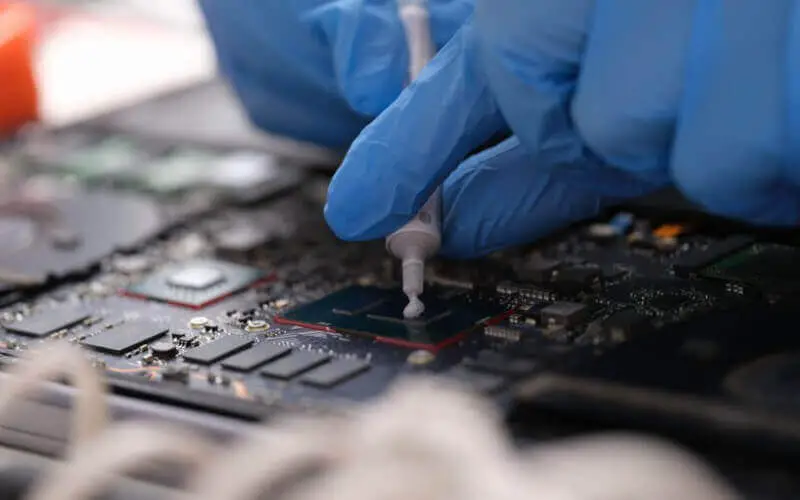As someone who enjoys building and tinkering with computers, I know how important it is to have the right components and tools to ensure that my system runs smoothly and efficiently. One such component is thermal paste.
Thermal paste is a substance applied between the CPU and the heatsink to improve heat transfer from the CPU to the heatsink, helping keep the CPU cool and preventing it from overheating.
When planning a new system or renovating an existing one, I often question if the CPU includes thermal paste. After all, the last thing I want is to spend hours putting together a new system only to find out that I forgot a critical component like thermal paste.
That’s why I’ve decided to write this article – to help answer the question, “Do CPUs come with thermal paste?” By examining different types of CPUs, their packaging, and the contents of those packages, I hope to provide a clear and comprehensive answer to this question.
Whether you’re a seasoned builder or a newcomer to the computer world, I hope this article will be helpful and informative.
Do CPUs Come With Thermal Paste?
When it comes to the question of whether CPUs come with thermal paste, the answer is not a straightforward one. It depends on the type of CPU you’re looking at and the brand and packaging.
Let’s start with an overview of different types of CPUs. Some CPUs come in a retail package, which includes a heatsink and fan, while others are sold as a bare processor only.
In the case of CPUs that come in a retail package, the heatsink and fan are usually pre-installed, and the thermal paste is often pre-applied. On the other hand, bare processors don’t come with a heatsink or fan, and the thermal paste is not included.
Now, let’s examine some common CPU brands and their packaging contents. For example, Intel CPUs often come in a retail package, with the heatsink and fan pre-installed and the thermal paste pre-applied. On the other hand, AMD CPUs typically come in a box without a heatsink or fan, and the thermal paste is not included.
It’s important to note that there are some exceptions to these generalizations and that not all CPUs from the same brand will have the same packaging contents.
Some Intel CPUs, for example, may come with thermal paste included, while others may have pre-applied thermal paste.
So, as you can see, whether or not CPUs come with thermal paste depends on the CPU type and the brand and packaging. In the next section, we’ll explore why thermal paste is included or not included in CPU packaging.
Why Is Thermal Paste Included Or Not Included In CPU Packaging?
Several factors are at play regarding the inclusion of thermal paste in CPU packaging, including cost considerations, technical requirements and limitations, market trends, and consumer preferences.
From a cost perspective, including thermal paste in CPU packaging can add to the overall cost of the CPU, and some manufacturers may choose not to include it to keep the cost down.
For example, bare processors are often sold at a lower price than retail packaged CPUs, and not including thermal paste helps keep the cost down.
From a technical perspective, pre-applying thermal paste can be challenging, as the application process is critical to the performance and longevity of the paste.
Additionally, some manufacturers may choose not to include thermal paste to give consumers the flexibility to choose their thermal paste or to use a different type of thermal interface material, such as thermal pads or thermal tapes.
Finally, market trends and consumer preferences play a role in whether thermal paste is included in CPU packaging.
For example, some consumers may prefer to use their thermal paste, and not having it included in the packaging gives them that flexibility. Others may prefer the convenience of having the thermal paste pre-applied and be willing to pay a higher price for that convenience.
So, as you can see, there are several reasons why thermal paste is included or not in CPU packaging. Whether you’re a seasoned builder or just starting, it’s important to understand these factors to decide what type of CPU is right for you.
Pros and Cons of Pre-Applied Thermal Paste
When it comes to pre-applied thermal paste, there are both pros and cons to consider. Let’s look at some of the key benefits and drawbacks of this type of thermal interface material.
Pros
- Convenience: One of the biggest benefits of pre-applied thermal paste is its convenience. With the paste already applied, there’s no need to worry about getting it right or damaging the CPU or heatsink during the application process. This can be especially helpful for those who are new to building computers or who don’t have a lot of experience with thermal paste applications.
- Reduced risk of damage: The thermal paste pre-applied reduces the risk of damaging the CPU or heatsink during the application process. This can be particularly important for those working with high-end or sensitive components.
Cons
- Lack of customization: With pre-applied thermal paste, you can’t choose the type of thermal paste you want to use or adjust the amount or thickness of the paste. This can be a drawback for those looking for maximum performance or who want to use a specific type of thermal paste.
- Quality control issues: Depending on the manufacturer, the quality and consistency of pre-applied thermal paste can vary. Some manufacturers may use lower-quality thermal paste or not apply it evenly, which can impact performance.
So, as you can see, there are pros and cons to the pre-applied thermal paste. Whether it’s the right choice for you will depend on your specific needs and preferences.
If you’re looking for convenience and reduced risk of damage, the pre-applied thermal paste may be a good option. However, if you’re looking for maximum performance and the ability to customize your thermal interface material, you may consider using your thermal paste.
Pros and Cons of Included Thermal Paste
Like pre-applied thermal paste, having it included in the CPU packaging also has pros and cons. Let’s take a closer look at some of this thermal interface material’s key benefits and drawbacks.
Pros
- Cost savings: By including thermal paste in the CPU packaging, manufacturers can keep the cost of the CPU down, which can be especially beneficial for budget-conscious consumers.
- Guaranteed availability: With thermal paste included, you don’t have to worry about finding it at a local store or ordering it online. This can be especially convenient for those hurrying to build their computer.
Cons
- Quality control issues: The quality and consistency of thermal paste included in CPU packaging can vary widely, depending on the manufacturer. Some manufacturers may use lower-quality thermal paste, which can impact performance, or may not apply it evenly.
- Limited options: With included thermal paste, you can’t choose the type of paste you want to use or adjust the amount or thickness of the paste. This can be a drawback for those looking for maximum performance or who want to use a specific type of thermal paste.
So, as you can see, there are pros and cons to having thermal paste included in CPU packaging. This may be a good choice if you’re looking for a cost-effective option and guaranteed availability.
However, if you’re looking for maximum performance and the ability to customize your thermal interface material, you may consider using your thermal paste.
Frequently Asked Questions
Does Ryzen Come With Thermal Paste?
AMD Ryzen CPUs provide users with a convenient solution to their cooling needs, as they come with a CPU cooler that includes thermal paste pre-applied. This eliminates the hassle of purchasing additional components and spending time applying them manually.
By featuring the thermal paste already applied, Ryzen CPUs streamline the process of setting up your computer and make it much simpler for users regardless of experience level.
Whether upgrading an existing machine or building one from scratch, Ryzen is an ideal choice if you want to save time and effort in the process.
Does Thermal Paste Come With The CPU Or Motherboard?
When shopping for a new CPU, you may wonder if thermal paste comes with it. The answer to that question depends on what you’re buying and from where.
Most CPUs don’t come bundled with thermal paste, but the CPU cooler will usually have some pre-applied. As a bonus, many aftermarket coolers have a packet included.
While the pre-applied paste may be enough for your needs, experienced users could benefit from using their thermal compound when assembling their PC for optimal cooling performance.
Conclusion
Whether or not CPUs come with thermal paste depends on the manufacturer and the specific CPU you’re looking at. Some CPUs come with pre-applied thermal paste, while others come with thermal paste included in the packaging.
Both options have pros and cons, such as convenience, cost savings, and quality control issues. It ultimately comes down to your personal needs and preferences when deciding whether to use included or pre-applied thermal paste or to choose your thermal interface material.
If you’re new to building computers or don’t have much experience with thermal paste application, pre-applied or included thermal paste may be a good choice.
However, if you’re looking for maximum performance and the ability to customize your thermal interface material, you may consider using your thermal paste.
Regardless of which option you choose, follow the manufacturer’s guidelines and instructions to ensure the best performance and longevity for your CPU.






